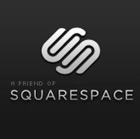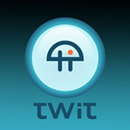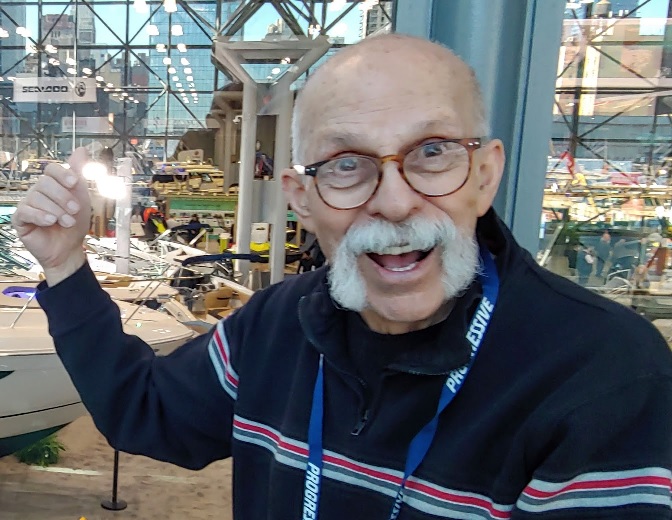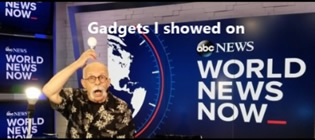Aerobie makes the jump from flying discs to making coffee on the fly!
 February 14, 2010
February 14, 2010  4 Comments
4 Comments Monday, February 15th, 2010 Netcast 1026
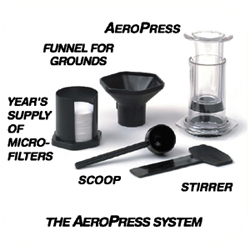 Aerobie, yes the folks that make those fun-flying rings have found a way to make a good cup on the fly! There’s a picture of their AeroPress on the left. It may look a touch complicated, but using it is pretty simple. First you place the Aeropress on top of your favorite coffee mug. Then put a measured scoop of coffee into the brewing chamber and pour hot water into the grounds. (Here’s something to remember, pour the hot water slowly. The fist time I used the AeroPress the water went right thorugh and make a super-weak brew. Then I started looking at the instructions. Turns out that if you pour the water slowly, the grounds get wet and slow down the brewing process so you get a deeper, richer flavor. Now that you’ve learned how to pour the water, once it’s in the brewing chamber, use the included stirrer to mix the coffee and water for about 10 to 15 seconds. Then a few seconds later place the plunger on top of the brewing chamber and push down gently. What’s neat about this coffee maker is clean-up is quick and easy. Unlike that French Press machines with the springy-thingy on the bottom, which is difficult to clean, with this unit you just pop out the block of coffee grounds into the garbage. They refer to that block of coffee grounds as the “puck” because it does like a mini-version of one. You can make 1 to 4 cups of coffee or espresso (enough for 1 or 2 mugs). It uses a micro paper filter and I was pleased to find that they include 320 of them! And the company says if you don’t mind giving the filter a mini-rinse you can use each one 3 or 4 times. Best news is that if you buy another 320 along with the AeroPress it only adds a few dollars to the order. Now there are sorts of tips on how to brew the best coffee and a quick web search showed there are devoted fans across the world offering videos and ways to improve your coffee making techniques. It retails for $25 to $35, but our friends at ThinkGeek have it at the low end, $25.99. (No, we don’t get a commission, but they did provide a sample so we could play with it.) There’s also a video on using the Aerobie at their website here:
Aerobie, yes the folks that make those fun-flying rings have found a way to make a good cup on the fly! There’s a picture of their AeroPress on the left. It may look a touch complicated, but using it is pretty simple. First you place the Aeropress on top of your favorite coffee mug. Then put a measured scoop of coffee into the brewing chamber and pour hot water into the grounds. (Here’s something to remember, pour the hot water slowly. The fist time I used the AeroPress the water went right thorugh and make a super-weak brew. Then I started looking at the instructions. Turns out that if you pour the water slowly, the grounds get wet and slow down the brewing process so you get a deeper, richer flavor. Now that you’ve learned how to pour the water, once it’s in the brewing chamber, use the included stirrer to mix the coffee and water for about 10 to 15 seconds. Then a few seconds later place the plunger on top of the brewing chamber and push down gently. What’s neat about this coffee maker is clean-up is quick and easy. Unlike that French Press machines with the springy-thingy on the bottom, which is difficult to clean, with this unit you just pop out the block of coffee grounds into the garbage. They refer to that block of coffee grounds as the “puck” because it does like a mini-version of one. You can make 1 to 4 cups of coffee or espresso (enough for 1 or 2 mugs). It uses a micro paper filter and I was pleased to find that they include 320 of them! And the company says if you don’t mind giving the filter a mini-rinse you can use each one 3 or 4 times. Best news is that if you buy another 320 along with the AeroPress it only adds a few dollars to the order. Now there are sorts of tips on how to brew the best coffee and a quick web search showed there are devoted fans across the world offering videos and ways to improve your coffee making techniques. It retails for $25 to $35, but our friends at ThinkGeek have it at the low end, $25.99. (No, we don’t get a commission, but they did provide a sample so we could play with it.) There’s also a video on using the Aerobie at their website here:
http://www.thinkgeek.com/homeoffice/kitchen/8e3a/
Hear this Netcast: www.twit.tv/dgw1026

